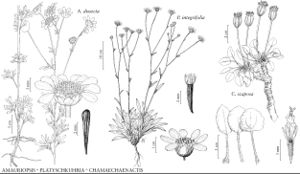Chamaechaenactis
Bull. Torrey Bot. Club 33: 155. 1906.
| Taxon | Illustrator ⠉ | |
|---|---|---|
 | Amauriopsis dissecta Platyschkuhria integrifolia Chamaechaenactis scaposa | Barbara Alongi Linda Ann Vorobik Linny Heagy |
Perennials, 2–7 (–9) cm (to 10–20+ cm across). Stems mostly subterranean (caudices relatively thick, branched; aerial stems essentially peduncles). Leaves mostly basal; alternate; petiolate; blades (1-nerved or 3-nerved) cordate, elliptic, ovate, or rounded, margins entire or distally ± crenate, revolute to ± plane, faces ± strigose and glanddotted, adaxial sometimes glabrescent. Heads discoid, borne singly. Involucres ± obconic, 6–15 (10–23 pressed) mm diam. Phyllaries 11–15 in 2 series (± erect, sometimes spreading in senescence, oblong to oblanceolate, ± unequal, herbaceous, abaxially densely villous, obscurely glandular). Receptacles convex, knobby, epaleate. Ray-florets 0. Disc-florets 10–30+, bisexual, fertile; corollas white to pinkish, tubes shorter than ± cylindric throats, lobes 5, ± deltate (style-branches stigmatic in 2 lines, appendages linear-oblong, blunt). Cypselae clavate, ± quadrangular with 8–12 obscure nerves, densely piloso-strigose, eglandular; pappi persistent, of 7–11, (distinct) oblanceolate to narrowly spatulate, erose scales in 2 series (midnerves prominent). x = 16.
Distribution
w North America
Discussion
Species 1.
Chamaechaenactis has been considered a close relative of Chaenactis, which has superficially similar heads. Nuclear rDNA evidence (B. G. Baldwin et al. 2002) suggests closer relationship to Bartlettia, Hymenopappus, and other members of Bahiinae sensu Baldwin. Such a placement was also suggested by Rydberg when he segregated Chamaechaenactis from Chaenactis.